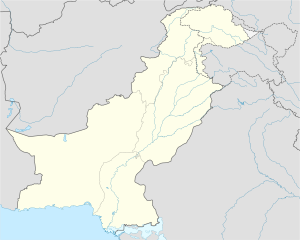
The Durrani Empire or the Afghan Empire, also known as the Sadozai Kingdom, was an Afghan empire that was founded by Ahmad Shah Durrani in 1747, that spanned parts of Central Asia, the Iranian plateau, and the Indian Subcontinent. At its peak, it ruled over the present-day Afghanistan, much of Pakistan, parts of northeastern and southeastern Iran, eastern Turkmenistan, and northwestern India. Next to the Ottoman Empire, the Durrani Empire is considered to be among the most significant Islamic Empires of the 18th century.

The Durrani dynasty was founded in 1747 by Ahmad Shah Durrani at Kandahar, Afghanistan. He united the different Pashtun tribes and created the Durrani Empire. which at its peak included the modern-day Afghanistan, Pakistan, as well as some parts of northeastern Iran, eastern Turkmenistan, and northwestern India including the Kashmir Valley.
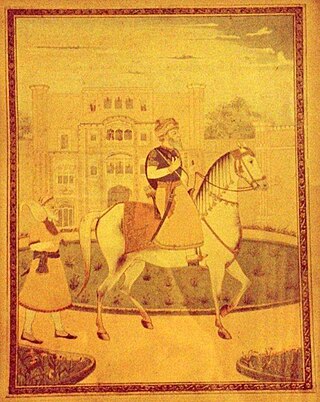
Sultan-ul-Qaum Sardar Jassa Singh Ahluwalia was a Sikh leader during the period of the Sikh Confederacy, being the Supreme Leader of the Dal Khalsa. He was also Misldar of the Ahluwalia Misl. This period was an interlude, lasting roughly from the time of the death of Banda Bahadur in 1716 to the founding of the Sikh Empire in 1801. He founded the Kapurthala State in 1772.
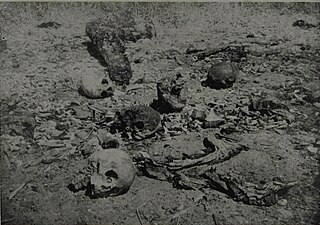
Vadda Ghalughara was the mass murder of unarmed Sikhs by the Afghan forces of the Durrani Empire during the years of Afghan influence in the Punjab region of the Indian subcontinent owing to the repeated incursions of Ahmad Shah Durrani in February 1762. It is distinguished from the Chhota Ghalughara. Mostly non-combatants were killed in the event, and an estimated that 10,000 to 50,000 Sikhs were killed on 5 February 1762.

Sardar Charat Singh, also romanised as Charhat Singh, was the founder of Sukerchakia Misl and father of Mahan Singh, and the grandfather of Ranjit Singh. He distinguished himself at an early age in campaigns against Ahmad Shah Abdali and along with 150 horsemen split from the Singhpuria Misl to establish the Sukerchakia Misl.

The Afghan–Sikh wars spanned from 1748 to 1837 in the Indian subcontinent, and saw multiple phases of fighting between the Durrani Empire and the Sikh Empire, mainly in and around Punjab region. The conflict's origins stemmed from the days of the Dal Khalsa, and continued after the Emirate of Kabul succeeded the Durrani Empire.
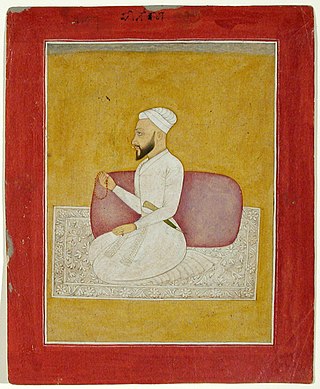
Adina Beg Khan was a Punjabi general and administrator who served as the last governor of the Punjab region of the Mughal Empire, including the provinces of Lahore and of Multan. He defeated Afghans after rising to power and was recognised as the Nawab of Punjab by Mughal emperor Alamgir II, who also gave him title of Jang Bahadur.
Zain-ud-Din Khan known as Zain Khan Sirhindi was the Mughal Faujdar of Sirhind, he was a serviceman of Shah Alam II, an ally of Najib-ud-Daula and Ahmad Shah Durrani. Zain Khan Sirhindi fought during the Third Battle of Panipat and strengthened Mughal rule in the region.

The Afghan-Maratha War was fought between the Afghan Empire under Ahmad Shah Durrani and the Maratha Empire and the Sikh Confederacy between 1758 and 1761. It took place in north-west India, primarily the region around Delhi and Punjab.

Dattaji Rao Shinde, also known as Dattaji Rao Scindia, was the second son of Ranoji Rao Shinde and Maina Bai, alias Nimba Bai. His elder brother was Jayappaji Rao Shinde and his younger brother was Jyotiba.
The Battle of Kup was fought on 5 February 1762, between the Afghan forces of Ahmad Shah Durrani and the Sikhs, under the command of Jassa Singh Ahluwalia and Charat Singh. Ahmad Shah Durrani and the Afghan forces reached Malerkotla, west of Sirhind. Different sources give various estimates on how many sikhs were present. According to Tom Landsford, nearly 30,000 Sikh men, women, children, and elderly laid encamped. According to Narendra Sinha, 40,000 Sikhs were present. According to Hari Ram Gupta, 50,000 Sikh soldiers laid encamped at Kup while 5,000 non combatants laid encamped at Pind Garma. Abdali's forces outnumbered the Sikhs in hand-to-hand combat and the Sikhs couldn't use their usual tactics of hit and run, but had to engage in battle while protecting the civilians at the same time. With surprise attack, the Sikhs threw a human ring around civilians as protection and fought the battle killing several thousand Afghans. Abdali was able to break the ring and carried out a full scale massacre of the Sikh civilians. Ahmad Shah's forces killed several thousand Sikhs, and the surviving Sikhs fled to Barnala. According to various different estimates, as many as 5,000 to 30,000 Sikh men, women, elderly and children were killed in what is known as the second Sikh genocide.
The Battle of Sialkot took place on 12 November 1763, between the Durrani Empire, led by Jahan Khan, and the Sukerchakia Misl, led by Charat Singh, as part of the Afghan-Sikh wars which concluded with Sikh victory.

Ahmad Shah Durrani, the founder of the Durrani Empire, invaded Indian subcontinent for eight times between 1748 and 1767, following the collapse of Mughal Empire in the mid-18th century. His objectives were met through the raids and deepened the political crisis in India.

The siege of Lahore took place in 1761 when the Sikhs besieged Lahore and captured it after facing no opposition from Durrani forces.
The Battle of Mahilpur was fought between the Sikh Misls and Adina Beg Khan against the Durrani Empire in December 1757.Following the 4th invasion of Ahmad Shah Durrani, he would appoint Timur Shah as the viceroy of Punjab with Jahan Khan as his deputy.The Afghans would appoint Adina Beg Khan as the faujdar of the Jalandhar Doaba and exempted him from attending court at lahore, on the condition that Adina Beg pay revenue to the Afghan government.Soon a dispute regarding the payment of revenue occurred between Adina Beg and the Afghans.This dispute soon escalated which resulted in Jahan Khan sending an Afghan force to arrest Adina Beg.Adina Beg formed a military alliance with the Sikhs under the command of Jassa Singh Ahluwalia and Vadbhag Singh Sodhi.Adina Beg also gained the support of Sadiq Beg Khan, Khwaja Mirza Khan, and Raja Bhup Singh.Adina Beg along with the Sikh forces fought the Afghans at Mahilpur.The battle resulted in a victory for Adina Beg and the Sikhs and resulted in the entire Jalandhar Doaba being occupied and sacked by the Sikh forces.
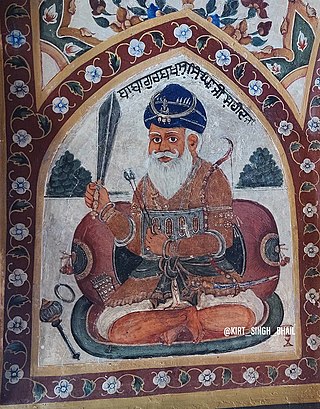
Baba Gurbaksh Singh was a Sikh warrior from the 18th century who served under the Shaheedan Misl of the Sikh confederacy. Gurbaksh Singh along with 29 other Sikh warriors led a last stand against the Afghan and Baloch forces on December 1, 1764, at Amritsar. It was in this skirmish that Baba Gurbaksh Singh along with 29 other Sikhs were killed.
The Battle of Darbar Sahib was fought in 1761, during the Afghan-Sikh Wars, between the Shaheedan Misl of the Sikhs and the Durrani Empire of Ahmad Shah Abdali aided by the Khanate of Kalat.
the Battle of Taraori in 1759 was a military engagement between the Durrani Afghans and the Marathas in the fields of Taraori, the Afghans were victorious.
The Second Battle of Lahore was fought in November 1759 by the Sikh forces led by Jassa Singh Ahluwalia and the Afghan forces led by Jahan Khan.
